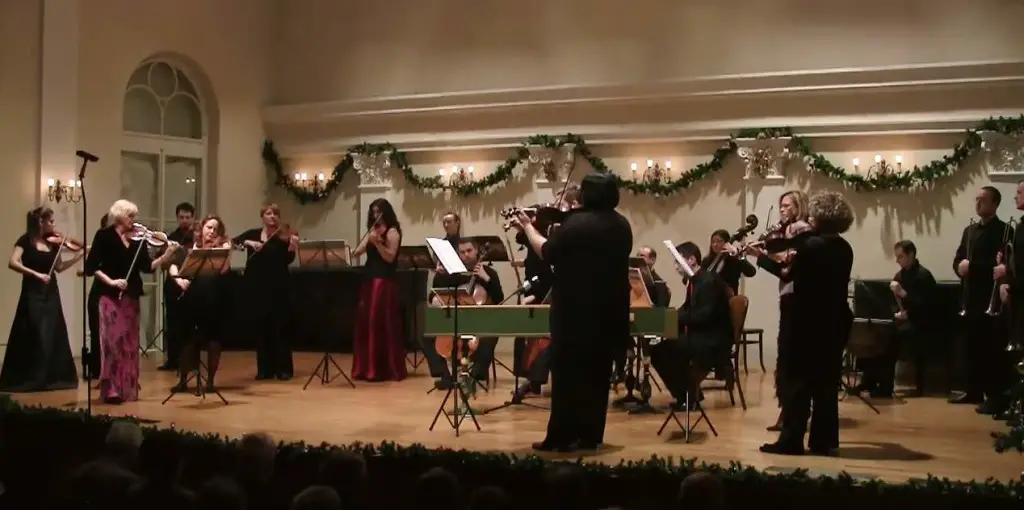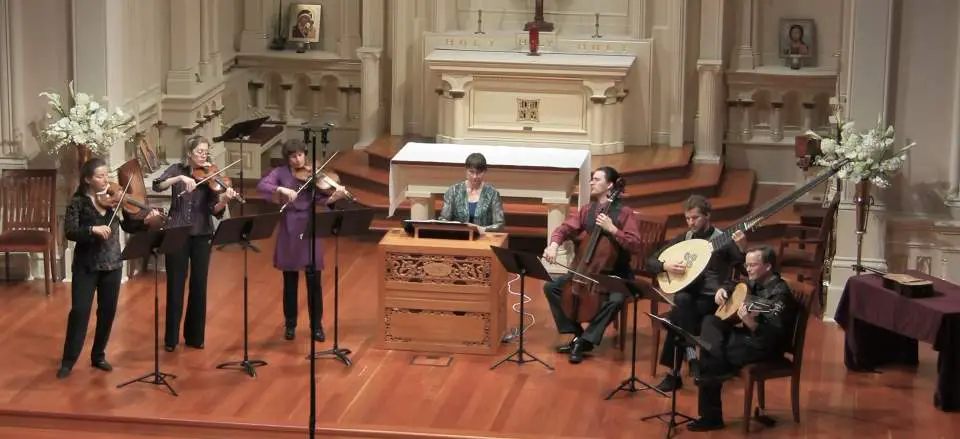Accompanied by the Croatian Baroque Ensemble, the British violinist Catherine Mackintosh performs “Air” (Air on the G-string) and “Gavotte” from Johann Sebastian Bach’s Orchestral Suite No. 3 in D major, BWV 1068. Recorded at the Croatian Music Institute, Zagreb, on December 5, 2010.
Johann Sebastian Bach’s Air on the G-String
“Air” is the third movement of Johann Sebastian Bach’s Orchestral Suite No. 3 in D major, BWV 1068. The piece is often referred to as “Air on the G String” due to August Wilhelmj’s arrangement of the piece for violin and piano, which involves playing entirely on the G string of the violin.
“Air” is one of Bach’s most famous works, known for its serene and soothing melody. It showcases Bach’s characteristic baroque style and his skill in composing intricate, emotive music.
The original orchestral suite is believed to have been written by Bach in the late 1730s. The “Air” movement is written in the key of D major and is marked as ‘Andante’ in the original manuscript, suggesting a relatively slow tempo.
In popular culture, “Air on the G String” has been used in various movies, commercials, and ceremonies due to its calming and elegant nature.
Bach’s Gavotte
The third movement, Gavotte I/II, is an energetic and lively dance. Gavotte is a traditional French dance characterized by a distinctive rhythm that typically starts on the third beat of the bar.
In Suite No. 3, the Gavotte I/II movement consists of two distinct gavottes. The first gavotte is played, followed by the second, and then the first is repeated again. This was a common practice during the Baroque period. The Gavotte I/II contrasts the serene and soothing melody of the preceding Air, demonstrating the range of Bach’s compositional prowess.
While Bach’s Orchestral Suite No. 3 is best known for its second movement, “Air on the G String,” the Gavotte I/II offers its own unique charm and contributes to the Suite’s diverse array of moods and styles.
Croatian Baroque Ensemble

The Croatian Baroque Ensemble is Croatia’s most distinguished ensemble specializing in the historically authentic interpretations of music from the Baroque and similar style periods on original instruments and their quality replicas. Founded in 1999, the ensemble consists of renowned young musicians, both instrumentalists and vocalists, who have already affirmed themselves in the performance of Baroque music.
In addition to their 7 concert cycles at the Croatian Music Institute, they perform on a regular basis at numerous national and international festivals, including:
- The Varaždin Baroque Evenings
- The Dubrovnik Summer Festival, the Split Summer Festival
- The Zagreb Baroque Festival
- The St. Donat Festival, the Histria Festival
- The Concerts at the Euphrasian Basilica
- The Rovinj Summer Festival
- The Lubenice Music Evenings
- The Osijek Baroque Church Music Festival
- The Mostar Festival
- The Pag Summer Festival
- The Slavonski Brod Summer Festival
- The Croatian Music Festival in Vienna
- The Central European Sacred Music Festival in Rome
- The Brežice Festival
- The Tesori Musicali Toscani Festival in Pisa
In their concert programmes, the ensemble often features soloists and conductors with an authentic approach to Baroque music performing (Richard Egarr, Herve Niquet, Werner Ehrhardt, Catherine Mackintosh, Stefano Montanari, Aapo Hakkinnen, Philip Pickett, David Staff, Teresa Caudle, Mimi Mitchell, Adrian Butterfield, Peter Lönnerberg, Ryo Terakardo, Laurence Cummings, Andreas Helm, etc).
The programmes of the Croatian Baroque Ensemble extensively feature Croatian baroque composers, i.e. those who worked in Croatia (F. Sponga-Usper, G. Usper, T. Cecchini, V. Jelić, I. Lukačić, G. Puliti, L. Sorkočević, etc.).
On the ensemble’s CD entitled Cecchini & Co., Laura Vadjon and Mario Penzar perform the Croatian and Italian baroque sonatas.
Other releases include a CD with Antonio Vivaldi’s The Four Seasons, and the HRBA Live CD with the ensemble’s most successful performances in the first 10 seasons. In 2009, the ensemble took part in the acclaimed international Dubrovnik Summer Festival’s production of G. F. Handel opera Acis and Galatea, directed by Dora Ruždjak Podolski, under the artistic leadership of Philip Pickett, a critic of the Jutatnji List magazine called “a miracle at Fort Lovrjenac”.
Owing to its highly professional, clear, and virtuosic interpretations, the Croatian Baroque Ensemble is considered one of Croatia’s finest ensembles by music critics and audiences alike. The ensemble’s line-up is flexible and, depending on the programmes, ranges from the smallest one including 3 musicians to big projects with a chamber choir and soloists.
“During the outstanding performance of this highly spirited ensemble, we could hear the breaking of strings, which not at all spoiled this gallant musical celebration” – Večernji List. “One of Zagreb’s finest music ensembles” – Jutarnji List.
The ensemble was awarded Orlando Prize for their performance “Gentle Love, Cruel Love” at the 65th Dubrovnik Summer Festival.
Catherine Mackintosh was one of the first of her generation to specialize in early string-playing techniques. After a conventional violin training at The Royal College of Music in London, she took up the viol and baroque violin and was immediately in demand from such pioneering groups as Musica Reservata, The English Consort of Viols, and The Consort of Musicke, with whom she sometimes played up to seven instruments in one concert!
Catherine was appointed the leader of The Academy of Ancient Music in 1973. During her fifteen-year tenure, she made countless recordings. Since the foundation of The Purcell Quartet in 1984 Catherine has concentrated more on solo and chamber music and has recorded Bach concertos for violin with The King’s Consort for Hyperion.
As a professor of baroque and classical violin and viola at The Royal College of Music since 1977, she has passed on her enthusiasm for early style in performance to countless younger musicians. She is frequently invited to direct workshops and give masterclasses. She is visiting professor of baroque violin and viola at The Royal Scottish Academy.
Sources
- The Croatian Baroque Ensemble on the Dubrovnik Festival website
- Catherine Mackintosh on Hyperion Records

